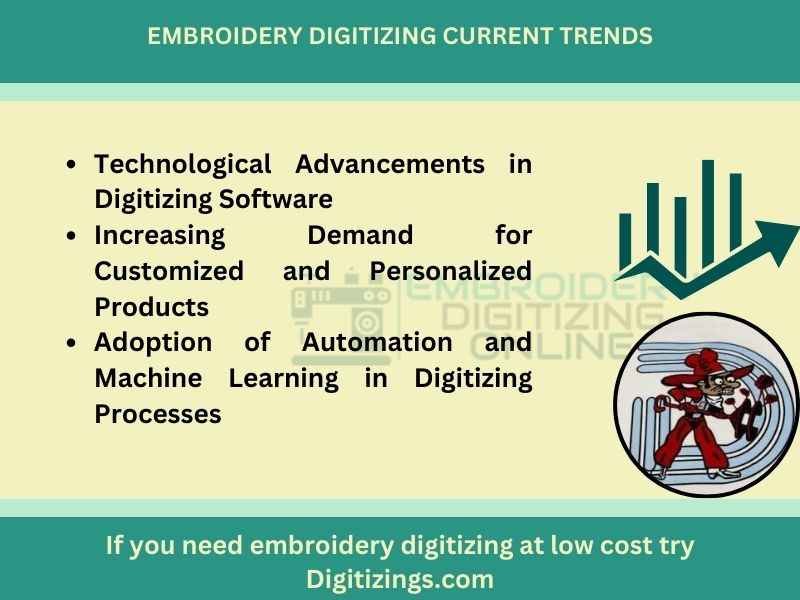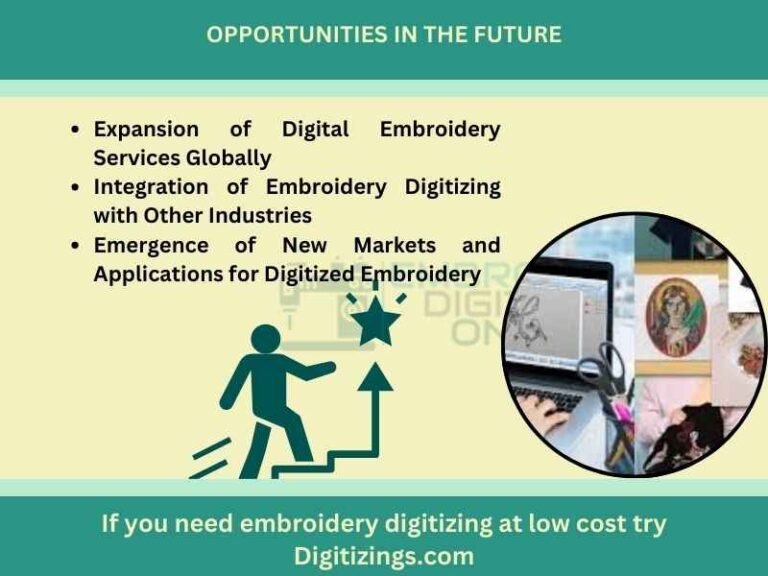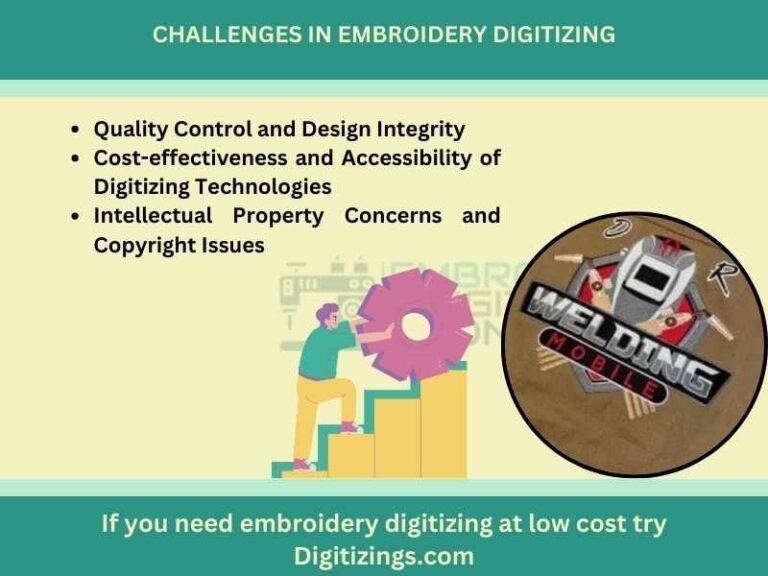Exploring The Scope Of Embroidery Digitizing In The Future
Embroidery digitizing, the process of converting artwork into digital embroidery files, has become a cornerstone of modern textile production. This overview delves into the expanding scope of embroidery digitizing and its profound significance in the textile industry.

Overview OF Exploring The Scope Of Embroidery Digitizing
By exploring its definition, importance, and future prospects, we aim to gain a comprehensive understanding of how digitizing techniques are revolutionizing textile manufacturing processes. Embroidery digitizing offers precision and efficiency unmatched by traditional hand embroidery methods, enabling manufacturers to replicate intricate designs with consistency and accuracy. Its importance lies in its ability to streamline production, reduce costs, and cater to diverse customer preferences.
As we look towards the future, understanding the evolving landscape of digitizing technologies is crucial for businesses to stay competitive and capitalize on emerging opportunities in the global market. Through this exploration, we seek to uncover the transformative impact of embroidery digitizing and envision its role in shaping the future of textile manufacturing.
Table of Contents
Embroidery Digitizing Current Trends

Embroidery digitizing has undergone significant transformations in recent years, driven by advancements in technology, evolving consumer preferences, and the demand for streamlined production processes.
This article explores three key trends shaping the landscape of embroidery digitizing: technological advancements in digitizing software, the increasing demand for customized and personalized products, and the adoption of automation and machine learning in digitizing processes.
Technological Advancements in Digitizing Software:
One of the most notable trends in embroidery digitizing is the rapid evolution of digitizing software technology. Manufacturers and designers now have access to sophisticated software tools equipped with advanced features and capabilities. These include improved stitch algorithms that enhance the precision and quality of embroidery designs, intuitive user interfaces that simplify the digitizing process, and real-time simulation capabilities that allow designers to preview their designs before production. These advancements have revolutionized the way embroidery designs are created, allowing for greater creativity, efficiency, and precision.
Increasing Demand for Customized and Personalized Products:
In today’s consumer-driven market, there is a growing demand for customized and personalized products across various industries. Consumers seek unique and one-of-a-kind items that reflect their individuality and style. This trend has led to a surge in the adoption of embroidery digitizing techniques to create bespoke designs tailored to specific customer preferences. From personalized apparel and accessories to custom corporate merchandise, businesses are leveraging digitizing technology to meet the increasing demand for personalized products. This trend not only enhances customer satisfaction but also provides businesses with a competitive edge in a crowded marketplace.
Adoption of Automation and Machine Learning in Digitizing Processes:
Automation and machine learning technologies are revolutionizing the embroidery digitizing process, making it more efficient and productive. Automated digitizing software utilizes algorithms and machine learning techniques to analyze and interpret design elements, optimizing stitch placement and density for optimal results. This automation streamlines the digitizing process, reducing the need for manual intervention and speeding up turnaround times. Additionally, automation ensures consistent quality across various embroidery projects, helping businesses meet the demands of a fast-paced market. As the adoption of automation and machine learning continues to grow, it is expected to further reshape the future of embroidery digitizing, making it more accessible, efficient, and cost-effective.
If you’re looking for a top-quality embroidery design digitizing & vector art service, look no further than ours! With quick turnaround times and excellent quality, we’re the perfect choice for anyone looking for a reliable and affordable option.
Get 50% OFF On Your First Order Always get a preview before you pay so that you know exactly what your design will look like. We guarantee you won’t be disappointed!
Opportunities in the Future

Following are the opportunities in the future :
Expansion of Digital Embroidery Services Globally:
The future is ripe with opportunities for the global expansion of digital embroidery services. As technological advancements continue to break down geographical barriers, businesses offering digital embroidery services can capitalize on a worldwide market. With the proliferation of digitizing tools and the accessibility of the internet, companies can extend their reach far beyond local regions. This global expansion not only opens doors to new clients but also facilitates collaborations and partnerships across borders.
By leveraging digital platforms for communication and marketing, embroidery service providers can establish a presence in diverse markets, driving growth and establishing themselves as key players in the global embroidery industry.
Integration of Embroidery Digitizing with Other Industries:
The integration of embroidery digitizing with various industries presents a wealth of opportunities for innovation and collaboration. Beyond its traditional applications in apparel, embroidery digitizing is finding its way into sectors such as fashion, interior design, and advertising. Fashion designers are incorporating digitized embroidery into their collections, adding intricate and captivating embellishments to garments.
Similarly, interior designers are using digitized embroidery to customize home decor, upholstery, and furnishings, offering clients unique and personalized design solutions. Additionally, advertisers are harnessing the power of digitized embroidery to create eye-catching branded merchandise and promotional materials. This convergence of embroidery digitizing with diverse industries not only expands its reach but also fosters creativity and cross-disciplinary partnerships, driving new avenues for growth and market expansion.
Emergence of New Markets and Applications for Digitized Embroidery:
Looking ahead, the emergence of new markets and applications for digitized embroidery presents exciting prospects for industry players. As technology continues to advance, the possibilities for applying digitized embroidery in innovative ways are virtually limitless. Industries such as healthcare, automotive, sports, and entertainment are increasingly recognizing the value of customized and personalized embroidered products. For instance, medical facilities are utilizing digitized embroidery to create personalized patient apparel and accessories, enhancing comfort and individuality for patients.
Similarly, automotive companies are integrating embroidered logos and designs into vehicle interiors, adding a touch of luxury and personalization to their products. Furthermore, sports teams and entertainment brands are leveraging digitized embroidery to produce unique fan merchandise and promotional items, fostering a sense of community and engagement among supporters. These emerging markets and applications underscore the versatility and adaptability of embroidery digitizing, paving the way for continued growth and innovation within the industry.
Challenges in Embroidery Digitizing:

Following are the main challenges in embroidery digitizing business:
Quality Control and Design Integrity:
- Maintaining consistency and accuracy throughout the digitizing process.
- Monitoring factors such as stitch density, color accuracy, and alignment.
- Preserving the integrity of designs, especially in complex or intricate patterns.
Cost-effectiveness and Accessibility of Digitizing Technologies:
- High initial investment costs for advanced digitizing software and equipment.
- Ongoing expenses for software updates, maintenance, and training.
- Limited accessibility for small businesses or individual designers with budget constraints.
Intellectual Property Concerns and Copyright Issues:
- Risk of unauthorized reproduction and distribution of copyrighted designs.
- Legal and ethical implications of using copyrighted materials without proper authorization.
- Complexity of navigating licensing agreements and copyright laws in the digital realm.
Conclusion
In wrapping up, the future of digitized embroidery holds immense promise for businesses. It’s crucial for them to navigate challenges like maintaining quality and adapting to new technologies. Staying updated with market trends and advancements is key to seizing opportunities and staying competitive. By embracing innovation and staying adaptable, businesses can unlock the full potential of digitized embroidery, expanding their reach and offering diverse products to meet evolving consumer demands.
Looking ahead, digitized embroidery isn’t just about production—it’s about transforming industries and enhancing consumer experiences. By integrating digitized embroidery into fields like fashion and interior design, businesses can tap into new realms of creativity and personalization. With services like embroiderydigitizing.online providing accessible and efficient solutions, businesses can confidently embark on this journey, enriching their projects and carving out success in the dynamic landscape of digitized embroidery.
If you’re looking for a top-quality embroidery design digitizing & vector art service, look no further than ours! With quick turnaround times and excellent quality, we’re the perfect choice for anyone looking for a reliable and affordable option.
Get 50% OFF On Your First Order Always get a preview before you pay so that you know exactly what your design will look like. We guarantee you won’t be disappointed!
FAQ's
The future of embroidery digitizing is bright, with advancements in technology opening up new possibilities for creativity and efficiency. As businesses increasingly adopt digital embroidery techniques, the industry is poised for growth and innovation.
Yes, embroidery remains in high demand across various industries. From fashion and apparel to promotional products and corporate branding, embroidered items continue to be sought after for their durability, aesthetic appeal, and customization options.
Embroidery digitizing offers numerous benefits, including enhanced precision, faster production times, and the ability to replicate intricate designs with ease. It also allows for customization and personalization, making it a popular choice for businesses looking to create unique branded merchandise.
Getting started with embroidery digitizing typically involves investing in digitizing software and equipment, such as embroidery machines and digitizing software. Additionally, gaining proficiency in design software and understanding embroidery techniques are essential steps in mastering the craft
Embroidery digitizing has applications across a wide range of industries, including fashion, sports, hospitality, and healthcare. Businesses in these sectors can leverage digitized embroidery to create branded apparel, uniforms, promotional items, and more, enhancing their brand visibility and customer engagement.












